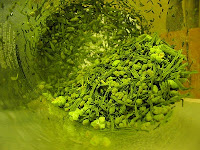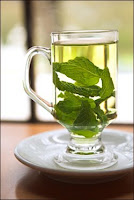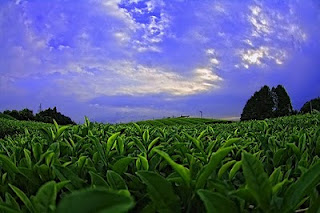I’ll be honest: while I’ve always loved tea, my introduction to the green variety came in the form of the Starbucks Green Tea Frappuccino. As a barista, I made these grassy-sweet milkshakes all day – and never liked it! Now I drink four hot cups a day between dinner and bed. Here’s the lowdown on the tea that grows on you and helps you grow.
Green tea, like white, black, and oolong, is made from the Camellia sinensis plant. The color of a tea is determined by the degree of processing it undergoes. Green tea skips the first stages of processing and is quickly heated (calling Firing or Kill-Green) to break down the enzymes that would cause oxidation. Therefore, green tea is the least processed and least oxidized of all C. sinensis teas.
Contrary to popular belief, green tea does not contain much caffeine. The average 8oz. cup of coffee has about 150mg of caffeine (8oz. of Starbucks drip coffee has 180mg, but the “Tall,” or small size, is 12oz. with about 260mg!). By contrast, an 8oz. mug of properly brewed green tea has only 20mg of caffeine. In addition, each time you re-steep the bag for a new cup, you get about one third of the previous mug’s amount of caffeine. (Stash Tea)
Speaking of properly brewed, never use boiling water with green tea! The compounds and minerals in green tea are delicate (remember, this is the least processed tea) and will break down quickly under rough conditions. To brew the perfect cup of green tea, steep the bag or loose leaf no longer than two to three minutes in water no hotter than 180 degrees. The boiling point for water at sea level is 212 degrees, so let your tea kettle sit for five to seven minutes after it screams.
While the Japanese varieties have generated a lot of commercial popularity, green tea originally comes from China. According to the Asian Arts Mall:
The origin of tea can be traced back to over 4000 years ago in China. No one is sure where and when tea was first brewed; stories about tea’s origins are more myth than reality.
One story tells that a legendary Chinese leader and medical expert, Sheng Nong, discovered tea as a medicinal herb in 2737 B.C. One day while he was boiling water under a tea tree, some tealeaves fell into Sheng’s pot of boiling water. After drinking some tea, he discovered its miraculous powers and immediately placed tea on his list of medicinal herbs.
Initially used as an offering and as medicine, tea became the most commonly used beverage during western Han dynasty. Buddhist monks started growing it around monasteries…a Buddhist monk introduced tea to Japan in the 6th Century and later in the 16th Century a Portuguese missionary introduced it to Europe. There began the history of Tea as an international drink.
This is still evident today in that China exports a projected 83% of the world’s green tea supply. Japan produces nearly 10% of the world supply of green tea but consumes almost all of that. The other major exporters are Viet Nam and Indonesia. (Intergovernmental Group on Tea)
As far as health claims for green tea, all we know for sure is that it contains polyphenols, specifically catechins (antioxidants widely believed to improve general health), as well as carotenoids, tocopherols, ascorbic acid (Vitamin C), chromium, manganese, selenium, and zinc. Some benefits attributed to green tea include: reduced risk of cardiovascular disease and cancer; increased bone density and cognitive function; prevention of cavities and kidney stones; improved fat oxidation and insulin and glucose regulation; reduced blood pressure and cholesterol; and protection of brain cells from degeneration. It is worth noting that although green tea has significantly more powerful antioxidants than black tea, it does not have black tea’s theaflavins (formed during oxidation in cultivation).
Some popular Japanese and Chinese green teas that you might know or ought to try:
- Gyokuro (Jade Dew) considered the highest grade of green tea, grown in shade to alter its flavor, from the first flush
- Sencha (Broiled Tea) most common Japanese green tea, grown in direct sunlight, from the first flush
- Tamaryokucha (Ball Green Tea) tangy, berry-like with a long almond aftertaste and a deep aroma
- Kamairicha (Pan-fried Tea) not steamed in the Kill-Green, not bitter like most Japanese tea
- Matcha (Powdered Tea) fine-ground tea cultivated similar to gyokuro, used in tea ceremonies and commercial flavorings
- Xi Hu Longjing (Dragon Well) one of the ten China Famous Teas; known for its orchid-like smell and green jade coloring
- Bi Luo Chun (Green Snail Spring) another China Famous; grown with apricot and plum trees – takes on fruity notes/aromas
- Huang Shan Mao Feng (Fur Peak) one of the ten China Famous Teas; hearty, rich and nutty flavor
- Xin Yang Mao Jian (Green Tip) not one of the ten China Famous Teas, but well known nonetheless
I heartily recommend green tea to anyone and everyone. Whether you have it hot, on ice, in ice cream, or mixed into snackbars, give it a try (or have some more). If you already have a favorite green tea blend or product, leave it here in the comments!
Leave your feedback and share this page to keep the discussion going!
Here’s a low-cost, five-star-rated tea to start you on your journey. Sencha, the high-grade common green tea, is my favorite. Quick tip: Squeeze some fresh lemon, lime, or orange into your hot green tea. The extra vitamin C helps the body to metabolize the extreme amounts of antioxidants, so you get more benefit for your mug.
Unless otherwise sourced, all information comes from Wikipedia and its prodigious list of sources.
Photo credits: Genmaicha by Karenglynn
Green Mint Tea by Crave Energy




2 pings